Love lasagna? Who doesn’t?
But really, what is it about lasagna that makes it so delicious? The cheesy goodness, tender noodles, or meaty sauce? Or all of it together?
Lasagna stands out from a simpler dish because all the layers pull different flavors and textures into one beautiful, delectable meal.
While you definitely wouldn’t want to taste “bulb lasagna,” (tulips and daffodils are absolutely not edible) bulb lasagna shares the same basic principle as your favorite Italian comfort food: layers.
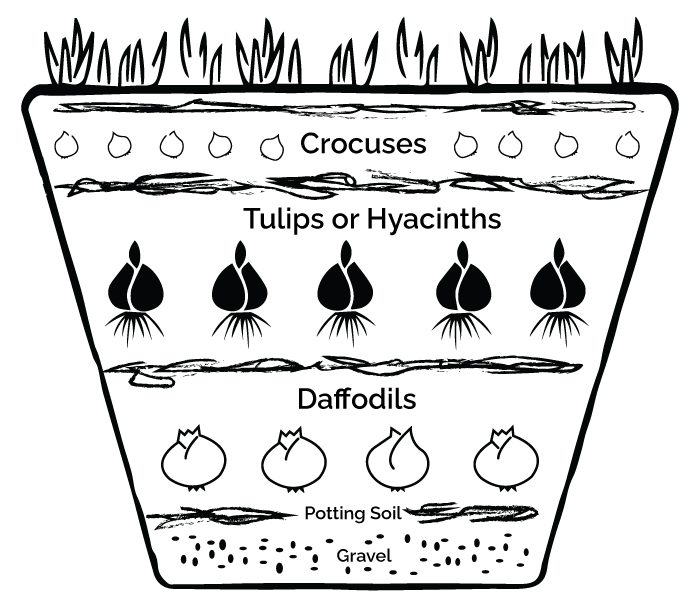
What is bulb lasagna?
Bulb lasagna, also called “double-decker” planting, is exactly like it sounds—it’s a method of planting bulbs where the bulbs are placed on top of each other, rather than in-line at the same depth. This planting method is great for succession planting and allows multiple flowers to grow in the same place.
Originating in the Netherlands, bulb lasagna came about as a way to plant tulips, daffodils, and hyacinths together for a long-lasting and vibrant spring display.
Growers have adapted this practice to other bulbs, since bulb lasagna is really just a fun spin on succession planting, a strategic practice that ensures your garden is always in bloom. Succession planting bulbs typically involves planting a new round of summer bulbs as spring bulbs die back, but you can save yourself time by planting the bulbs at the same time!
Why layer spring bulbs?
Spring bulbs are gorgeous, but their beauty is fleeting. After several weeks of fragrant, colorful blooms, spring bulbs will naturally die back as the weather warms and the world transitions to summer. Rather than have holes in your garden or unsightly dead foliage, plant summer bulbs to fill the gaps. As spring bulbs fade, summer bulbs will just be coming into their prime, hiding any holes in your garden and providing showy blooms.
Staggered blooming isn’t just beautiful, it’s necessary for pollinators. As their early spring food sources dry up, another is provided in their place, so these beneficial insects don’t go elsewhere for their next meal.
Layering bulbs in a pot or the ground means one or two plantings provide months of blooms. But it isn’t as easy as tucking all your favorite bulbs in the same hole together—you want to plant bulbs at the right depth and spacing to promote healthy growth.
You can optimize your garden even more by planting early-season bloomers in front of later blooming varieties, and taller varieties behind.
Choosing the best bulbs for bulb lasagna
Bulb lasagna is a popular practice with fall-planted bulbs like tulips, daffodils, and hyacinths, but many other bulbs are great candidates for layered planting.
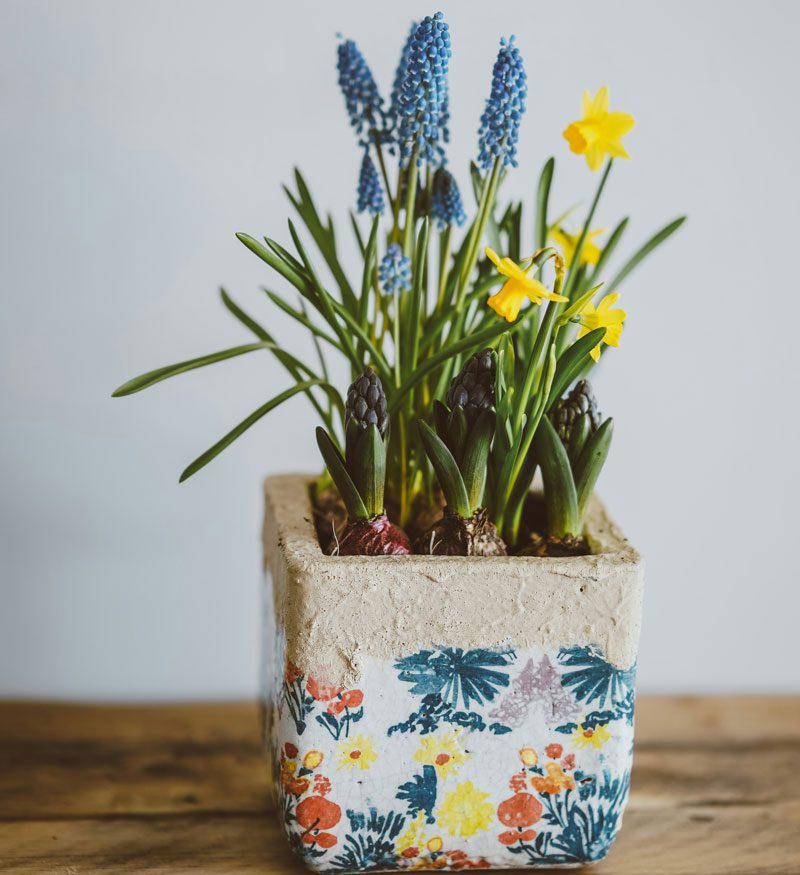


Factors to consider
Bloom Time
- One of the major advantages of bulb lasagna is the seamless transition from one blooming plant to another, so choose plants that flower at different times!
- Most bulbs can be organized into early-season, mid-season, and late-season bulbs, and bloom time determines where each bulb should go in the lasagna. Plant early-season bulbs the deepest, tuck in midseason bulbs next, and place late-season bulbs closest to the surface.
Height
- When planning a bulb lasagna, choose a variety of plants with different heights for the fullest effect. Plant the tallest-growing plants deepest in the ground and the shortest plants on the surface of the soil.
Color
- For added fun, plan your bulb lasagna with certain colors in mind! Shop our best-selling color-themed bulb and seed mixes here.
Lighting needs
- Some bulbs need full sun to thrive, while others prefer partial shade. Research your bulbs’ lighting requirements and layer them with other bulbs that have similar needs.
Compatibility
- While some plants just don’t grow well together, many more will. It’s important to know which bulbs are compatible before you plant them in the ground.
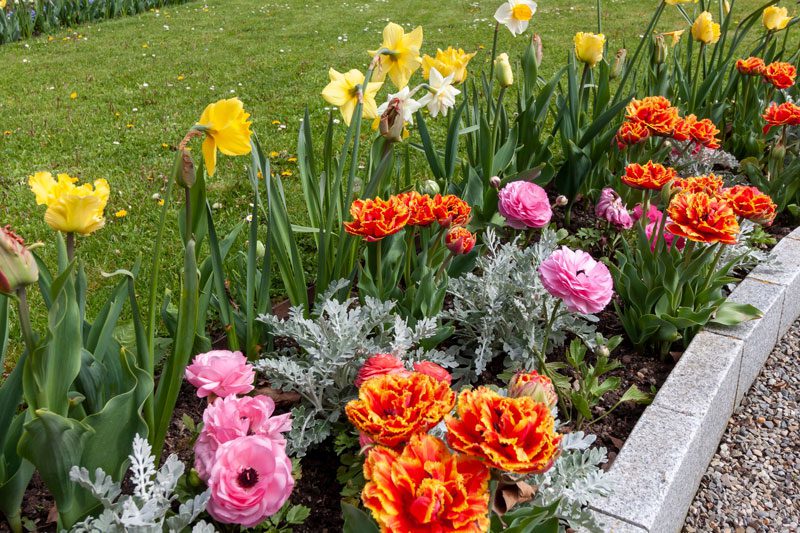
Companion planting fall and spring bulbs
One of the best approaches to the bulb lasagna method is to pair fall-planted and spring-planted bulbs together for continuous flowering. Summer-blooming bulbs will begin growing soon after early tulips and daffodils die back, hiding holes in your garden.
The lasagna technique works for any combination of fall-planted and spring-planted bulbs, but is only effective if all of the bulbs are hardy in your area. You can also lift any cold-sensitive bulbs at the end of the season; otherwise, freezing winter temps may kill your bulbs.
You might not want to plant canna lilies and dahlias at the same time you plant tulips and daffodils, since spring-planted bulbs are not always frost-tolerant. You can, however, plant summer bulbs on top of cold-hardy bulbs once the danger of frost has passed.
Here are a few spring-planted bulbs that it’s not too late to plant:
- Anemone
- Ranunculus
- Gladiolus
- Begonia
- Calla lily
- Canna lily
- Dahlia
- Caladium
- Crocosmia
- Elephant ear
- Freesia
- Hosta
How to plant bulb lasagna
Put your (gardening) apron on and let’s start crafting a gorgeous bulb garden.
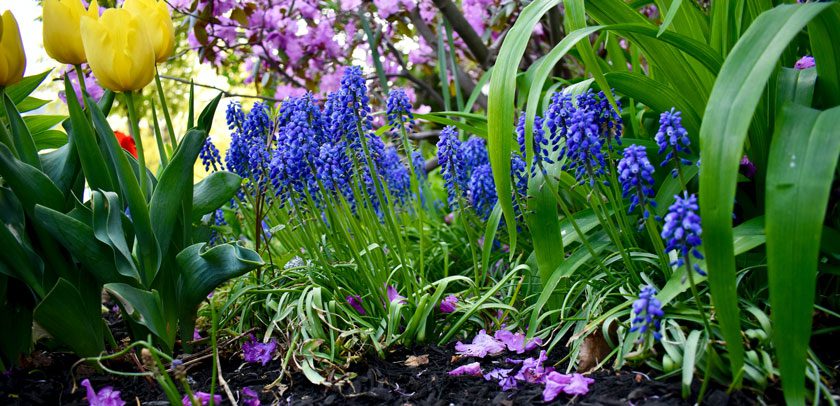
Prepare the planting site
Bulbs do best in fertile, well-draining soil with a neutral pH. Choose a location that gets full sun and prepare the ground for planting by loosening the soil, removing any large rocks, and pulling any weeds. Turn compost into the soil or add a balanced, granular fertilizer if needed.
Dig a trench or several large holes–depending on whether you want your bulbs to grow in rows or patches. Dig the hole deep enough to accommodate two or three layers of bulbs; this could be up to a foot deep with some of the largest bulbs.
If you’re growing your bulb lasagna in a container, fill a large pot with a few inches of quality potting soil.
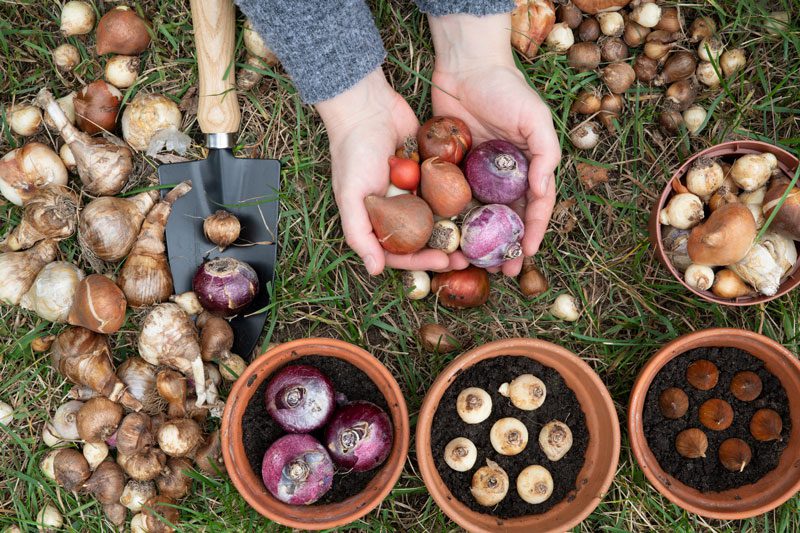
Layer your bulbs
To successfully layer bulbs, it’s important to know when certain species bloom. Typically, the smallest bulbs (like hyacinths) bloom first, followed by larger bulbs like daffodils and tulips.
For perfect layers, follow these steps:
The process of layering bulbs is similar whether you plant into a container or a pot, but the size of your pot may limit how many bulbs you can plant. Most bulbs need between four to six inches of space, so a ten-inch pot will hold two layers and a 14-inch pot can hold up to three layers.
How many layers should there be in a bulb lasagna? Most growers who use the bulb lasagna method plant two or three layers. Many bulbs don’t mind being tucked in tightly together, so build the lasagna as thick as you want!
Care and maintenance of bulb lasagna
Mulching bulb lasagna with seasoned wood chips, compost, or other organic material does a few things: first, it clearly marks where you planted your bulbs so you won’t dig them up later; second, mulch insulates the bulbs from freezing temperatures (particularly beneficial for cold-sensitive bulbs); and lastly, mulch helps retain moisture, keeping your bulbs hydrated and your flowers fresh.
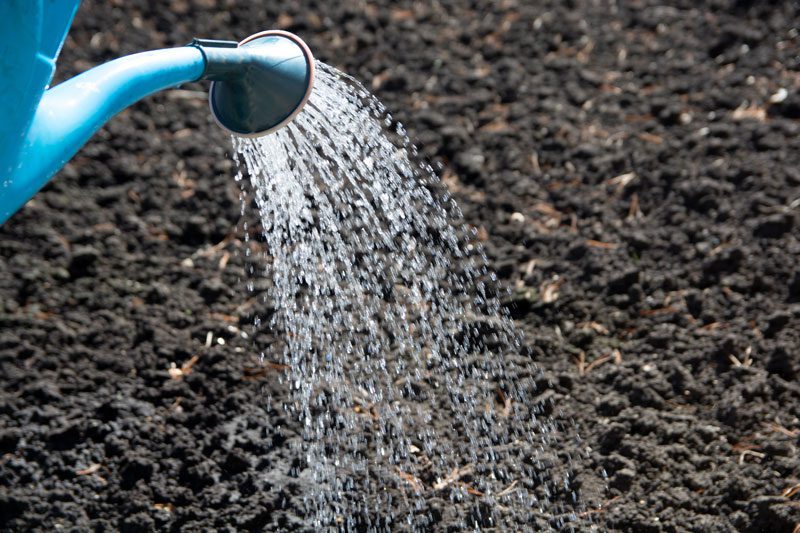
Water bulb lasagna immediately after planting and for the following week, then you can taper off the watering unless your area experiences heat waves or drought. Bulbs are fairly low maintenance, requiring very little attention other than the occasional watering or weeding.
Some bulbs may need division every three to five years, but that’s no reason not to grow bulb lasagna! When it’s time to inspect summer bulbs, simply dig them up (once they’re gone dormant) and divide if necessary. Replant, and let nature do the rest.
Bottom Line
Companion planting bulbs, whether in “bulb lasagna” or in a succession of early, midseason, and late varieties, is the best way to enjoy year-round blooms. As long as you choose compatible varieties with similar needs, you can trust that spring and fall bulbs won’t mind sharing a little space and sunlight.Want us to plan your garden for you? You’ll love the easy beauty of our Continuous Blooms Garden (Bulbs) or the wide variety in our Continuous Blooms Garden (Bulbs and Seeds). Or maybe you want to mix and match your favorite varieties from the Eden Brothers shop!